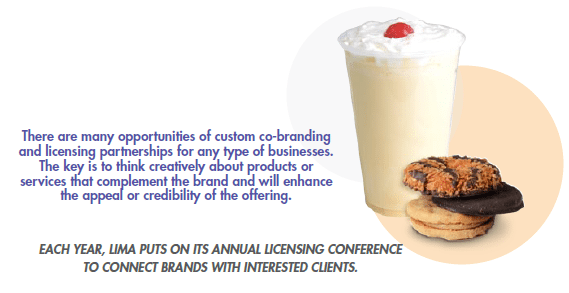Most customers ordering the new Nacho Cheese Doritos® Locos Tacos, a taco with a shell made of the famous Nacho Cheese Doritos® Chips, from the chain Taco Bell won’t question the reason why or how their favorite chips brand made it to a quick service restaurant (QSR), they simply enjoy it. From its slogan, “Taco Bell on the Inside. Doritos® on the Outside,” it is easy to understand that this product results from a marketing strategy called co-branding. From retail shelves to QSRs, licensing and co-branding are everywhere and at many different levels. Whether it is a product or a whole store concept, partnerships between brands are expanding, and for a good reason: it’s working.
Licensing and Co-Branding, in Short
Let’s start with quick definitions of the two concepts. According to Entrepreneur.com, licensing lets companies instantly tap the existing production, distribution and marketing systems that other companies may have spent decades building. In return, the licensor gets a percentage of the revenue from products or services sold. Licensing fees typically amount to a small percentage of the sales price but can add up quickly. The other type of partnering strategy, co-branding, is an arrangement that associates a single product or service with more than one brand name. Companies will work together on associating logos, color schemes or brand identifiers to a specific product that is designated for this purpose.
According to The Licensing Letter, retail sales of licensed merchandise increased 1.6 percent worldwide in 2012, to reach $153.2 billion. The U.S. and Canada accounted for 62.2 percent of the total. The retail sales of licensed merchandise in both countries grew steadily the last few years reaching $95.3 billion in 2011 with character licensing, corporate brand licensing, fashion and sports licensing. While licensing continues to increase every year, it is becoming more and more competitive. Because of limited shelf-space  available, retailers are more skeptical about taking products in or characters that have not been tested. At the same time, changing consumers who are more trend-conscious make it more difficult to predict new entertainment trends. This is the reason why today, classic brands or characters can put a premium on their licensing rights as they will more likely offer businesses long-term value and consistent business.
available, retailers are more skeptical about taking products in or characters that have not been tested. At the same time, changing consumers who are more trend-conscious make it more difficult to predict new entertainment trends. This is the reason why today, classic brands or characters can put a premium on their licensing rights as they will more likely offer businesses long-term value and consistent business.
Co-branding has become a popular strategy for companies as well, especially for franchises. Both companies capitalize on the strength of the two brands in order to increase the extra money consumers are willing to pay, but also to make the product or service harder to copy by private label manufacturers, or to combine the characteristics associated with these brands into one product. The concept of co-branded entities has become more prominent in the restaurant sector in recent years, but foodservices typically combine similar concept brands like KFC and Taco Bell.
Brand Value: The Real Power of Co-Branding and Licensing
Investopedia.com defines perceived value as the worth that a product or service has in the mind of the consumer. The consumer’s perceived value of a good or service affects the price that he or she is willing to pay for it. Most consumers are not aware of the true cost of production for the products they buy. Instead, they simply estimate how much certain products are worth to them. This is why, in order to charge a higher price for their products, businesses should develop marketing strategies to create a higher perceived value for their products.
Companies invest a lot of resources such as time and finances to acquire a positive status in customers’ minds. Brands are the promise to customers that they can expect quality from their products. Firms invest a lot on the image of their brands to increase sales and loyalty, and this is why licensing and co-branding can have a very positive impact once a popular brand is associated with another product. An interesting finding from airline companies, for instance, was that in-flight coffee ratings went up once passengers found out that Starbucks coffee was being served. While the coffee served before was the same, consumers immediately perceived it as better because of the brand’s reputation.
Licensing plays a big role in the value perceived by customers. Using a well-established brand enhances authenticity and credibility according to the Licensing Institute Association (LIA). For this reason, licensing can be extremely valuable when a business decides to extend into new categories of products or new geographical markets.
Successful Case Studies In franchise co-branding, two or more franchise brands get together to market and sell either a new product or their respective product in one establishment in order for each to extend their market share.
Bruegger’s Bagels and Caribou Coffee are recent examples of successful co-branding. By partnering at the end of 2013, the two brands brought bagels and coffee closer by opening a store offering both products. In this case, the separately owned companies didn’t have to invest in individual product line development but could instead provide complementary offerings to the table. While this case is a no-brainer, some co-branding strategies fail by confusing customers when the products are too different from each other or because there was no synergy or thought behind building the partnership.
Another successful partnership started in the summer of 2008 between Dairy Queen and Girl Scouts. The famous ice cream chain launched the new flavor Girl Scouts Thin mint Cookie Blizzard after a licensing agreement with Girl Scouts of the USA. A year later, Dairy Queen announced in a press release that they served more than 10 million of these treats, making it the most popular limited-time-offer flavor in Blizzard history. The two iconic brands saw a mutual advantage in licensing and continue to work on developing more flavors.
Advantages and Disadvantages of Co-branding
Co-branding increases visibility and market share for both companies involved. In the Bruegger’s Bagels and Caribou Coffee example, the co-branded store was able to attract customers who wanted coffee as well as customers who were seeking a bagel. This allowed the co-branded shops to draw in a greater range of customers. Likewise for the partnership between Tim Horton and Cold Stone Creamery: while the coffee chain does most of its sales in the morning and early afternoon, Cold Stone has more customers in the afternoon and early evening. By having a co-branded franchise, the stores increased their traffic during the entire day.
The disadvantages of co-branding and licensing are the lengthy negotiations and complex processes associated with profit-sharing agreements and other legal arrangements. What both parties need to keep in mind while working on such contracts is that neither franchise has a disparity or financial advantage over the other. By partnering together, individual franchises who co-brand can share promotional and operational costs, which can be a huge savings to both. This is true especially for franchises that have nationwide locations. Pizza Hut and Taco Bell, for instance use the same building at some of their locations. The companies oftentimes share their employees and a kitchen as well. Barnes & Noble and Target have Starbucks coffee in many of their stores, allowing the coffee chain to use a heavy traffic retail space while the super market and the book store offer their customers coffee, paying a percentage of sales to Starbucks.
Co-branding and licensing allow businesses to share a brand’s reputation. This can be both an advantage and a disadvantage. When consumers develop positive associations with their favorite brands, it can transfer to the co-brand. However, if the co-brand has some negative associations, these can also impact the other brand and hurt its reputation. Another drawback is brand equity dilution; this happens when, after a merger, each brand loses its unique identity and appeal.
Deciding on Licensing or Co-branding
There are many opportunities of custom co-branding and licensing partnerships for any type of businesses. The key is to think creatively about products or services that complement the brand and will enhance the appeal or credibility of the offering. A good place to start brainstorming ideas is by thinking about other types of companies that are successfully serving your target market. It might even be worth asking your customers to identify other companies with which they do business and see if your business can somehow be related. It is important to develop guidelines that will be right for your strategy and allow you to consider arising opportunities. For instance, some brands develop guidelines such as sharing complementary values, partnering only with high-quality value brands and maintaining the ability to keep approval rights for marketing initiatives.
Research existing co-branding and licensing examples to help you determine if they would be a good fit and why. Inquire within companies you would be interested in and understand their history with co-branding and licensing. LIMA and Biztree.com offer detailed checklists for licensing and co-branding agreements that will guide you towards the necessary steps and procedures.
Deciding whether going into licensing or co-branding should be part of a long thought-out process subject to conversations and meetings internally to make sure the strategy around potential partnerships is in line with the business and capabilities. There will always be risks associated with either licensing or co-branding, but it can also result in a successful move for the development and expansion of your business.

